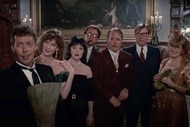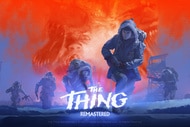Create a free profile to get unlimited access to exclusive videos, sweepstakes, and more!
High Score creators on how they scored rare Street Fighter, Space Invaders, and Gay Blade interviews

With Netflix’s original docuseries High Score, filmmakers Melissa Wood and France Costrel set out to deliver episodes that would reveal the unexpected personal stories behind the video games and consoles that established the industry. The six-episode season, now available on the streamer, covers a rough timeline of the first two decades of the gaming industry, from Pong up to early first-person shooters like Doom. And what it excels at most is rooting out the previously unheralded names, faces, and games that were foundational for what has come since.
In our continuing discussion with Wood and Costrel, SYFY WIRE asks them about some of the series’ more surprising reveals that represent the heart and soul of their endeavor. From the hunt for a copy of the influential, underground RPG Gay Blade in “Role Players,” to getting rare interviews with some of Japan’s legendary creators and artists, they tell us how those moments define their series.
In Episode 3, the history of the underground game Gay Blade reveals a lot about the subcultures in RPGs, as well as its importance to the LGBTQ gaming community. How did you finally get a copy in time for air?
Melissa Wood (Executive Producer): Pure luck, I think, with the timing. France, do you remember?
France Costrel (Director, Executive Producer): Basically, we found it because of a woman who works at the Berlin Computer Games Museum. She decided to do a compilation of LGBTQ games. And, obviously, Gay Blade is a very crucial one. And so, through the social media, she actually managed to get a copy of it. But then, it was quite a thing for us to get a copy and also make it work. Our post supervisor had to ask a lot of friends to help us get a sense of how do we [capture the game play]? We don't have the old computer for it. We had to get one! We had to make it work. And then, if you look at the footage, it's all our names playing it. We were playing it, just trying to figure it out. [Laughs.]
Wood: Yeah, poor Leann, she not only had to figure out how to open up the files and get it to play on our computer, but then we made her play it so we would have something to show.
Costrel: It's a hard game!
Wood: We would see her sitting by the window playing it and getting frustrated because we were hoping that she’d get to the next level so we’d have more material to show of that game. [Laughs.]
Costrel: I think the story was so good. It's really fascinating. We wanted to celebrate creativity, and we realized that a lot of games actually were really anchored in their time and had been created with a very strong motive behind it. It wasn’t just like, “Let's make money and let's make a game!” In fact, it wasn’t the case for most of them. Going back to the original [idea for the series], the diversity was rooted as well in the creation process of this game.
Let’s talk about your interviews with some of the titans of Japanese gaming. Getting many of the creators of that era on camera isn’t easy. What was your process in landing some of your subjects?
Wood: France is the director of all the Japan shoots. She was there for close to four weeks.
Costrel: It was really fun to film this in Japan, obviously, but I will definitely say there were some challenges. There is a cultural aspect of it. Getting access was tricky, where we had to sometimes go through the PR routes. But, what was actually amazing was that once you get access to one person, they all know each other in some sort of way.
For example, with Street Fighter, the game producer, [Akira] Nishitani, is amazing. He gave us so much of his time. But [Akira] Yasuda, who does the drawing and is the artist behind all the characters, doesn’t want to do media, and doesn’t really do it, to be honest. I think he's done it once. But once Nishitani [did it], he called him and asked him. We brought presents and made it very Japanese. And then once we were with him, he wouldn’t stop showing us things and drawing with us. But overall, it was difficult access, and I've learned a lot working there.
Is there a favorite moment with any of the creators there?
Costrel: I think the cutest thing ever filming things there was when the Space Invaders creator Nishikado arrived. He had something wrapped, like a total secret under his arm. It was under this old paper and this old rope that, seriously, I feel like has been wrapped like since the '80s. He was like, “Here are my original drawings for Space Invaders.” He unwraps it, and we're all like, “Oh, my God, this is the best thing ever!” And it was just so cute because he's like a child himself. His suit kind of looked like it was also from the '80s, and he's just still wearing it. And he has his little Space Invaders laces on.
Is he like royalty in Japan?
Costrel: When we went on the Tower of Tokyo to film that vista of Tokyo. We had this idea of the [CGI] invaders coming from the sky. And [up there] people were asking, “Who is he, who is he?” And I didn't really want to say because it's not in their culture to be known for something. On the contrary, they're often saying, “I didn't invent this. We had a team. I wasn’t the one.” I was like, "Well, you kind of were!” [Laughs.] But then when you tell people he made Space Invaders, they're all like, “Oh, my God, it's God!” It's amazing.
Is that humbleness in regards to their creations also because their business was so focused on not releasing spoilers about new games and consoles?
Costrel: You know, I think, to be honest, that these people were never really asked that much about their creations. To go back to the creator of Space Invaders, it's actually not in the series, but he told us that he wasn’t allowed to tell his family, not even his wife, that he did Space Invaders for 10 years because this was under the company [policy]. So, 10 years later he told his wife, “Hey, by the way, that was me behind Space Invaders.” It shows how they look at work. I think they look at games in such a prolific way, as well. They were genuinely really happy that we would ask them about all that, and that we wanted to reminisce about their work and celebrate it.
High Score is available now on Netflix.



























